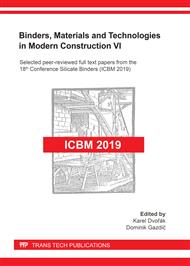[1]
S.S. Gaiduk. Investigation of thixotropic properties of adhesive materials based on polyvinyl acetate. – Proc. of BSTU. 2013. No2. pp.130-134.
Google Scholar
[2]
E.V. Korobko. Viscous-plastic and thixotropic properties of modified polyvinyl acetate adhesives. – Proc. of BSTU. 2016. No 2. pp.219-224.
Google Scholar
[3]
S.S. Gomon, A.P. Pavlyuk, O.V. Yushchuk. Investigation of the work of wood for chopping along the fibers under the action of repeated loads. Resource-saving materials, structures, buildings and structures: Coll. Sciences. NUPGP, 2015. Issue 30. pp.116-122.
Google Scholar
[4]
S.I. Ovsyannikov, D.Yu. Shapovalov. Increasing the strength of adhesive joints of wooden structures. Bulletin of Science and Education of the Northwest of Russia, 2018, Vol.4, No.4, pp.1-6.
Google Scholar
[5]
P.V. Krivenko, O.N. Petropavlovskii, G.V. Vozniuk. Alkaline aluminosilicate binder for gluing wood board materials. J. KEM. Vol. 761 2018. - pp.11-14.
DOI: 10.4028/www.scientific.net/kem.761.11
Google Scholar
[6]
S. Guzii, P. Krivenko, O. Bondarenko, T. Kopylova. Study on physico-mechanical properties of the modified alkaline aluminosilicate adhesive-bonded timber elements. J. SSP. Vol. 296. 2019. pp.112-117.
DOI: 10.4028/www.scientific.net/ssp.296.112
Google Scholar
[7]
P. Krivenko, S. Guzii, (2018). The effect of modifying additives on the modulus of elasticity and strength of adhesives based on an alkaline aluminosilicate binder. Proceed. of the 20. Ibausil. Internationale Baustofftagung. – Weimar, Germany. Tagunsbericht – Band 1. – pp.2-1213 – 2-1218.
Google Scholar
[8]
P. Kryvenko, V. Kyrychok, S. Guzii (2016), Influence of the ratio of oxides and temperature on the structure formation of alkaline hydro-aluminosilicates, Eastern-European Journal of Enterprise Technologies. Vol. 5(5-83), pp.40-48.
DOI: 10.15587/1729-4061.2016.79605
Google Scholar
[9]
Ulker, O. (2016). Wood Adhesives and Bonding Theory. Adhesives – Applications and Properties. doi: https://doi.org/10.5772/65759.
Google Scholar
[10]
Guzii, S. (2017). Investigation of the influence of organomineral additives on the colloid-chemical properties of geocement dispersion. Technology Audit and Production Reserves, 3 (1 (35)), 38–43. doi: https://doi.org/10.15587/2312-8372.2017.105678.
DOI: 10.15587/2312-8372.2017.105678
Google Scholar
[11]
P. Krivenko, S. Guzii, A. Kravchenko, Protection of timber from combustion and burning using alkaline aluminosilicate-based coatings. J. Advanced Materials Research. 688 (2013) 3-9. https://doi.org/10.4028/www.scientific.net/AMR.688.3.
DOI: 10.4028/www.scientific.net/amr.688.3
Google Scholar
[12]
A. Kravchenko, S. Guzii (2015). Determining the fire resistance properties of timber, protected by geocement-based coatings. Eastern-European Journal of Enterprise Technologies Vol. 1(5), pp.38-41. doi: https://doi.org/10.15587/1729-4061.2015.36843.
DOI: 10.15587/1729-4061.2015.36843
Google Scholar
[13]
P.V. Krivenko, S. G. Guzii, O.P. Bondarenko, (2019). Alkaline Aluminosilicate Binder-Based Adhesives with Increased Fire Resistance for Structural Timber Elements. KEM, 808, 172–176. doi: https://doi.org/10.4028/www.scientific.net/kem.808.172.
DOI: 10.4028/www.scientific.net/kem.808.172
Google Scholar
[14]
V.I. Bolshakov, at al. Refractories for lining of blast furnace and their interaction with blast furnace slag. Fundamental and applied problems of ferrous metallurgy: Coll. Sciences. Dnepropetrovsk: ICM of NAS of Ukraine, 2005. Issue. 10. pp.244-260.
Google Scholar
[15]
J.K. Makishev. Features of the process of carbonization of wooden structures of long service life. Internet-magazine Technosphere Security Technologies, (http://ipb.mos.ru/ttb) Issue No 5 (63), 2015, pp.1-8.
Google Scholar
[16]
Sychev M.M. (1974). Inorganic adhesives. L. Chemistry,160 p.
Google Scholar
[17]
Bruyne N.A., Houwink R. (1951). Adhesion and Adhesives. NY, Amsterdam, London, Brussels.
Google Scholar
[18]
S. Guzii, P. Kryvenko, O. Guzii, S. Yushkevych (2019). Determining the effect of the composition of an aluminosilicate binder on the rheotechnological properties of adhesives for wood. Eastern-European Journal of Enterprise Technologies Vol. 6/6(102), pp.30-37.
DOI: 10.15587/1729-4061.2019.185728
Google Scholar


